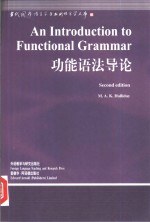

功能语法导论PDF电子书下载
- 电子书积分:14 积分如何计算积分?
- 作 者:(澳)M.A.K.Halliday著;胡壮麟导读
- 出 版 社:北京:外语教学与研究出版社
- 出版年份:2000
- ISBN:7560019730
- 页数:439 页
Part Ⅰ The Clause 1
1 Constituency 3
1.1 Constituency in writing 3
1.2 Constituency in speech 7
1.3 Rhythm:the foot 7
1.4 Intonation:the tone group 9
1.5 Syllables and phonemes 11
1.6 The significance of constituent structure 12
2.1 Grammatical constituency 17
2 Towards a functional grammar 17
2.2 Maximal and minimal bracketing 20
2.3 Labelling 24
2.4 Classes and functions 28
2.5 Subject,Actor,Theme 30
2.6 Three lines of meaning in the clause 33
3 Clause as message 37
3.1 Theme and Rheme 37
3.2 Simple Themes of more than one group or phrase 39
3.3 Theme and mood 42
3.4 Other characteristic Themes 48
3.5 Multiple Themes 52
3.6 Clauses as Themes 54
3.7 Predicated Themes 58
3.8 Theme in dependent,minor and elliptical clauses 61
3.9 Thematic interpretation of a text 64
4 Clause as exchange 68
4.1 The nature of dialogue 68
4.2.1 Structure of the Mood 71
4.2 The Mood element 71
4.2.2 Meaning of Subject and Finite 75
4.3 Other elements of Mood structure 78
4.3.1 Structure of the Residue 78
4.3.2 Modal Adjuncts 81
4.3.3 Conjunctive Adjuncts 83
4.3.4 Vocatives and Expletives 85
4.4 WH-interrogative,exclamative and imperative clauses 85
4.5 Polarity and modality 88
4.6.1 Ellipsis 92
4.6 Absence of elements of the modal structure 92
4.6.2 Minor clauses 95
4.7 Clause as Subject 96
4.8 Texts 99
5 Clause as representation 106
5.1 Process,participant and circumstance 106
5.1.1 Modelling experience 106
5.1.2 Process,participants and circumstances 107
5.2 Material processes:processes of doing 109
5.3 Mental processes:processes of sensing 112
5.4 Relational processes:processes of being 119
5.4.1 Relational processes 119
5.4.2 Intensive processes:attributive 120
5.4.3 Intensive processes:identifying 122
5.4.4 Token and Value 124
5.4.5 Summary of attributive and identifying(intensive)clauses 128
5.4.6 Circumstantial and possessive processes 130
5.5.1 Behavioural processes 138
5.5 Other process types;summary of process types 138
5.5.2 Verbal processes 140
5.5.3 Existential processes 142
5.5.4 Summary of process types 143
5.6 Other participant functions 144
5.6.1 Beneficiary 144
5.6.2 Range 146
5.7 Circumstantial elements 149
5.7.1 Types of circumstance 152
5.7.2 The status of circumstances 158
5.8 Transitivity and voice:another interpretation 161
Part Ⅱ Above,Below and Beyond the Clause 177
6 Below the clause:groups and phrases 179
6.1 Groups and phrases 179
6.2 Nominal group 180
6.2.1 Experiential structure of the nominal group:from Deictic to Classifier 181
6.2.2 Experiential structure of the nominal group:interpretation of ordering;the Qualifier 187
6.2.3 Experiential structure of the nominal group:the Thing 189
6.2.4 A note on interpersonal and textual contributions 190
6.2.5 Logical structure of the nominal group 191
6.2.6 Head and Thing 194
6.3 Verbal group 196
6.3.1 Experiential structure of the verbal group 196
6.3.2 Logical structure of the verbal group 198
6.3.3 Finite,sequent and non-finite tense systems 200
6.3.4 Phrasal verbs 207
6.4 Adverbial group,conjunction group,preposition group 210
6.4.1 Adverbial group 210
6.4.2 Conjunction group 211
6.4.3 Preposition group 212
6.5 Prepositional phrase 212
6.6 Summary of word classes 214
7 Above the clause:the clause complex 215
7.1 'Clause complex'and'sentence' 215
7.2 Types of relationship between clauses 216
7.3 Types of interdependency:parataxis and hypotaxis 221
7.4 Elaborating,extending,enhancing:three kinds of expansion 225
7.4.1 Elaboration 225
7.4.2 Extension 230
7.4.3 Enhancement 232
7.4.4 Expansion clauses that are not explicitly marked for any logical-semantic relation 239
7.4.5 Embedded expansions 242
7.4.6 Acts 248
7.5 Reports,ideas and facts:three kinds of projection 250
7.5.1 Quoting('direct speech'):verbal process,parataxis 250
7.5.2 Reporting('indirect speech'):mental process,hypotaxis 252
7.5.3 Reporting speech,quoting thought 254
7.5.4 Projecting offers and commands 257
7.5.5 Free indirect speech 260
7.5.6 Embedded locutions and ideas 263
7.5.7 Facts 264
7.5.8 Summary of projection 269
7 Additional:Group and phrase complexes 274
7A.1 Parataxis:groups and phrases 274
7A.2 Hypotaxis:nominal group 276
7A.3 Hypotaxis:adverbial group/prepositional phrase 277
7A.4 Hypotaxis:verbal group,expansion(1):general 278
7A.5 Hypotaxis:verbal group,expansion(2):passives and causatives 282
7A.6 Hypotaxis:verbal group,projection 288
8 Beside the clause:intonation and rhythm 292
8.1 Introductory:foot and tone group 292
8.2 Rhythm 292
8.3 Tonicity 295
8.4 Nature of the information unit 295
8.6 Given+New and Theme+Rheme 299
8.7 Tone 302
8.8 Tonic and pretonic 304
8.9 Key 305
8.10 Tone as expression of relationship in a unit complex 306
9 Around the clause:cohesion and discourse 308
9.1 The concept of cohesion 308
9.2 Reference 312
8.5 Meaning of Given and New 313
9.3 Ellipsis and substitution 316
9.4 Conjunction 323
9.5 Lexical cohesion 330
9.6 The creation of texture 334
10 Beyond the clause:metaphorical modes of expression 340
10.1 Rhetorical transference 340
10.2 Grammatical metaphor 342
10.3 Ideational metaphors 343
10.3.1 Metaphors of transitivity 344
10.3.2 The representation of metaphorical forms 346
10.3.3 Spoken and written language 349
10.3.4 Ideational metaphors and nominalization 352
10.4.1 Metaphors of modality 354
10.4 Interpersonal metaphors 354
10.4.2 A further account of modality 355
10.4.3 Metaphors of mood 363
Appendices 368
1 The'silver'text:analysis and interpretation 368
2 A note on the grammar of little texts 392
3 Variations on a causal theme 398
Further Reading 404
Bibliography 413
文库索引 435
- 《培生高级英语语法 练习册》培生教育 2019
- 《物联网导论》张翼英主编 2020
- 《材料导论》张会主编 2019
- 《化工传递过程导论 第2版》阎建民,刘辉 2020
- 《功能涂料》刘仁主编 2018
- 《海洋功能食品》王卉 2019
- 《功能食品 第2版》孟宪军 2017
- 《计算机自适应英语语用能力测试系统设计与效度验证 以TEM4词汇与语法题为例》张一鑫著 2019
- 《二十四史导读 第1册 (附《清史稿》导读)》孟繁华,许嘉利主编 2013
- 《大数据导论》林子雨编著 2020
- 《中风偏瘫 脑萎缩 痴呆 最新治疗原则与方法》孙作东著 2004
- 《水面舰艇编队作战运筹分析》谭安胜著 2009
- 《王蒙文集 新版 35 评点《红楼梦》 上》王蒙著 2020
- 《TED说话的力量 世界优秀演讲者的口才秘诀》(坦桑)阿卡什·P.卡里亚著 2019
- 《燕堂夜话》蒋忠和著 2019
- 《经久》静水边著 2019
- 《魔法销售台词》(美)埃尔默·惠勒著 2019
- 《微表情密码》(波)卡西亚·韦佐夫斯基,(波)帕特里克·韦佐夫斯基著 2019
- 《看书琐记与作文秘诀》鲁迅著 2019
- 《酒国》莫言著 2019
